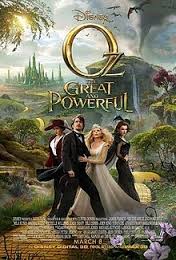 This last weekend the Redbox near my house finally had a copy of “Oz: The Great and Powerful” in stock. I love the Wizard of Oz and couldn’t wait to see the prequel to this iconic film. My childhood is full of memories of watching the original movie around Thanksgiving time every year. I also remember all of those Wicked Witch induced nightmares that would follow. However, this time around . . . I walked away with some non-profit and fundraising thoughts.
This last weekend the Redbox near my house finally had a copy of “Oz: The Great and Powerful” in stock. I love the Wizard of Oz and couldn’t wait to see the prequel to this iconic film. My childhood is full of memories of watching the original movie around Thanksgiving time every year. I also remember all of those Wicked Witch induced nightmares that would follow. However, this time around . . . I walked away with some non-profit and fundraising thoughts.
Without spoiling anything for those of you who haven’t seen “Oz: The Great and Powerful,” it should come as no surprise that there are parallels between the original movie and the prequel. For example, in both movies as the Wizard and Dorothy make their way to the Emerald City for the first time, they meet up with a cast of characters who join them on the journey and play valuable roles down the road.
Another parallel comes at the end of the movie. In the original film, the wizard presents “The Three Gifts“:
- The Scarecrow get his diploma in lieu of an actual brain
- The Cowardly Lion gets his medal in lieu of actual courage
- The Tin Man gets his heart shaped clock in lieu of an actual heart
A similar scene occurs at the end of “Oz: The Great and Powerful“.
Some people might conclude cynically that these are acts of a powerless person who is posing as a great and powerful wizard and relying upon his background as a con man and traveling circus magician back in Kansas. I am not of this opinion and invite you to refresh your memory of how things went down by watching this short YouTube clip of the scene in question:
[youtube=http://www.youtube.com/watch?v=ky7DMCHQJZY]
What I see is a smart man who knows his limitations and is doing a masterful job of working within those limitations to give deserving people what they want and need.
While watching the parallel scene in “Oz: The Great and Powerful,” I had a fundraising revelation. It was rooted in a conversation I had with a fundraising professional last week. She was concerned about a few board volunteers who are always chirping about how their non-profit organization needs to be run more like a for-profit business and how greater attention must be given to concepts like “return on investment” for donors.
While program outcomes and community impact are on the lips of many non-profit professionals nowadays, the reality is that not all non-profit organizations are the same. For example, it is probably easier for a non-profit youth development agency to demonstrate outcomes and impact than a domestic violence shelter for women. It is also most likely easier for a non-profit health clinic to show ROI than an art museum.
 If your agency is not in a position where you can make your donors’ wishes come true, then you better have skilled staff who possess talents and skills like The Wizard.
If your agency is not in a position where you can make your donors’ wishes come true, then you better have skilled staff who possess talents and skills like The Wizard.
Just to be clear . . . I am NOT suggesting that you need to hire snake oil salesmen. What I am suggesting is that you identify and hire talent staff who:
- understand what you donors need and want
- understand what the agency is capable of and not capable of providing
- have the ability to identify similar things that can be provided in lieu of what the donors desire
In the movie, The Wizard knows that he can’t give the Scarecrow a real brain. So, he gives him a college diploma instead. He also gives a wonderful explanation of why it is as good as having an actual brain. In the world of philanthropy, your non-profit staff may not have good impact data on how much less violent the world is for women because of your shelter, but you do have wonderful stories to share with donors about how for one night you made a world of difference in one woman’s life.
If you go back and watch that Wizard of Oz YouTube clip again, I suspect you will see many important skill sets — traits —

characteristics being demonstrated by The Wizard that are equally important for fundraising professionals and non-profit staff:
- persuasion
- well-spoken and clear in thought
- thinking fast on your feet
- great storyteller
- showmanship
On a side note, I also just love that scene in the movie because of how it relates to our work as fundraising and non-profit professionals. Did you catch what the wizard said to the Tin Man when presenting him with his pseudo-heart? If not, here is the quick transcript:
“Back where I come from there are men who do nothing all day but good deeds. They are called phil….er…..phil…er…er….good-deed-doers and their hearts are no bigger than yours, but they have one thing you haven’t got! A testimonial! Therefore, in consideration of your kindness, I take pleasure at this time in presenting you with a small token of our esteem and affection. And remember, my sentimental friend, that a heart is not judged by how much you love, but by how much you are loved by others.“
LOL . . . phil….er…..phil…er…er….good-deed-doers . . . I LOVE IT!!!
Does your non-profit organization have a “wizard” working behind the curtain of your donor communications program? How are you determining what donors want to see and hear? How are you still giving them what they want when it may not be realistic? Please use the comment box below to share your thoughts. We can all learn from each other!
For those of you who are big Wizard of Oz fans like me, I wrote a multi-part series of blog posts two years ago with a Wizard of Oz theme. I will re-blog those posts this week. I hope you enjoy this week’s trip down the yellow brick road.
Here’s to your health!
Erik Anderson
Founder & President, The Healthy Non-Profit LLC
www.thehealthynonprofit.com
erik@thehealthynonprofit.com
http://twitter.com/#!/eanderson847
http://www.facebook.com/eanderson847
http://www.linkedin.com/in/erikanderson847

 This last weekend the
This last weekend the  If your agency is not in a position where you can make your donors’ wishes come true, then you better have skilled staff who possess talents and skills like The Wizard.
If your agency is not in a position where you can make your donors’ wishes come true, then you better have skilled staff who possess talents and skills like The Wizard.
 This morning I am asking for your help with a small project I am working on. A few weeks ago I agreed to help one of my favorite non-profit organizations with a staff transition. Not only did their development director move on to greener pastures at the end of the summer, but their executive director also recently resigned. So, the board asked me to step into the void and help their management team with a variety of year-end miscellaneous projects (e.g. year-end holiday mailing, 2013 budget construction, resource development plan, etc).
This morning I am asking for your help with a small project I am working on. A few weeks ago I agreed to help one of my favorite non-profit organizations with a staff transition. Not only did their development director move on to greener pastures at the end of the summer, but their executive director also recently resigned. So, the board asked me to step into the void and help their management team with a variety of year-end miscellaneous projects (e.g. year-end holiday mailing, 2013 budget construction, resource development plan, etc). This question was inspired by a string of two or three grants in a row that this organization had just written. As a businessman, he asked this question because he is accustom to looking at everything through a “return on investment” (ROI) lens. In hindsight, this is what he saw:
This question was inspired by a string of two or three grants in a row that this organization had just written. As a businessman, he asked this question because he is accustom to looking at everything through a “return on investment” (ROI) lens. In hindsight, this is what he saw: Seriously, your feedback this morning will directly help another organization in its pursuit of developing fundraising best practices. Your participation will take all of a minute or two this morning. Please weigh-in. Your collective wisdom is massive and will bring tremendous value to this organization’s discussion. You can consider the few minutes that you invest in responding to this request as your “good turn” this holiday season. Please pay it forward!
Seriously, your feedback this morning will directly help another organization in its pursuit of developing fundraising best practices. Your participation will take all of a minute or two this morning. Please weigh-in. Your collective wisdom is massive and will bring tremendous value to this organization’s discussion. You can consider the few minutes that you invest in responding to this request as your “good turn” this holiday season. Please pay it forward!